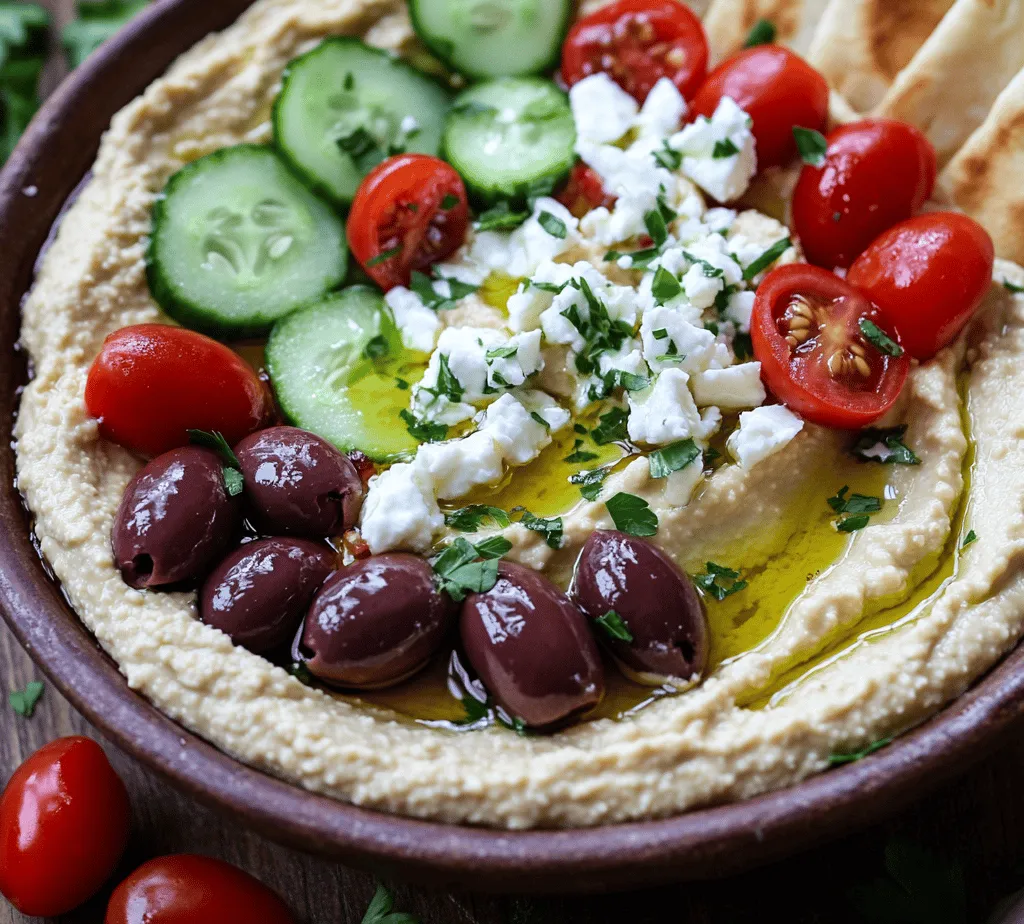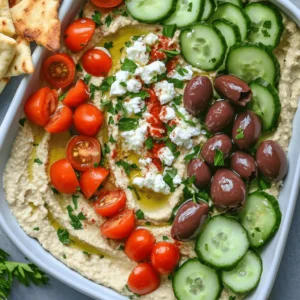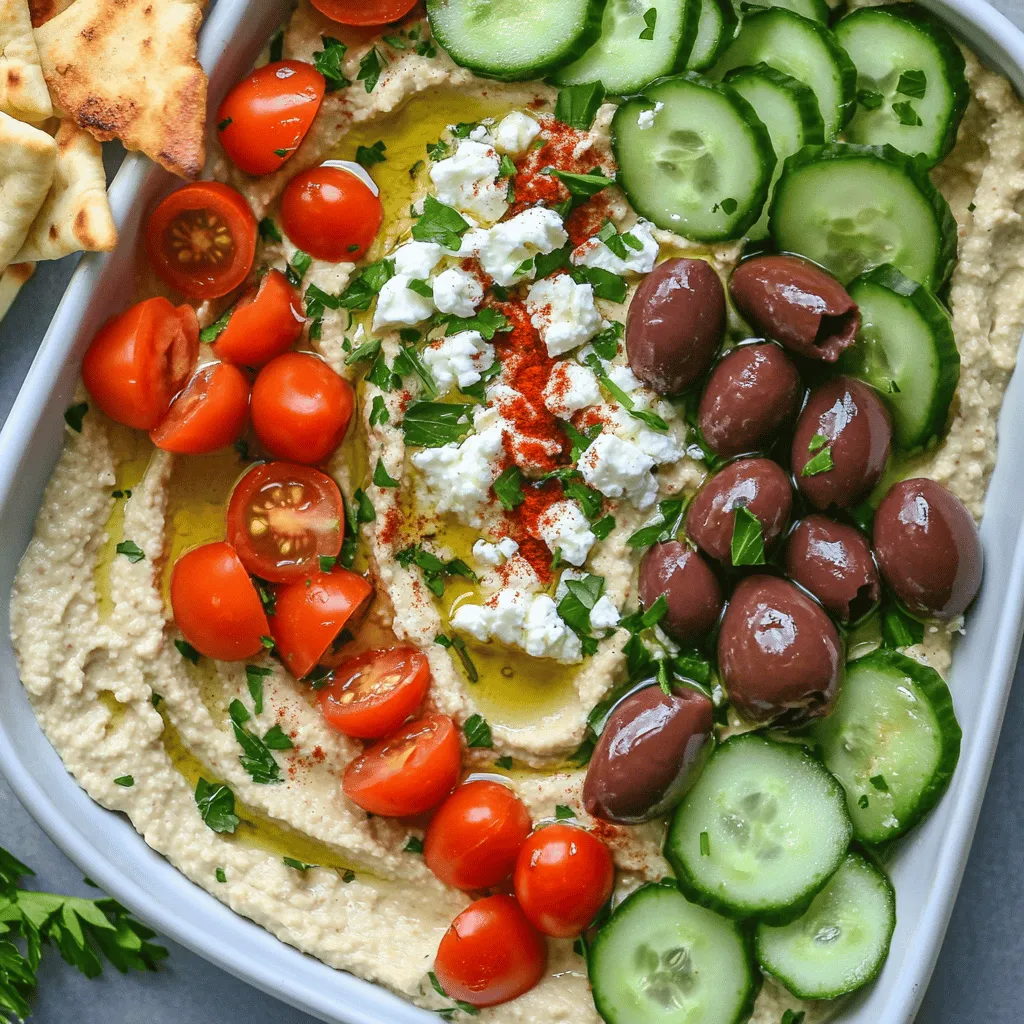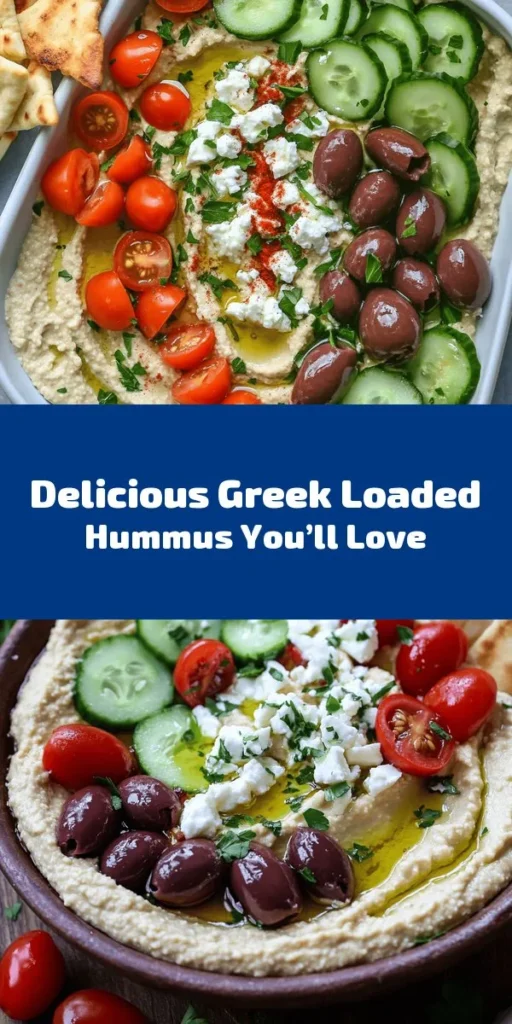Introduction
Hummus is far more than just a dip; it’s a celebrated staple of Mediterranean cuisine that has garnered global attention for its rich flavor and versatile use. Originating from the Middle East, this chickpea-based spread is not only delicious but also packed with nutrients, making it a popular choice for health-conscious eaters. With its creamy texture and savory taste, hummus can be enjoyed in countless ways—spread on pita bread, served with fresh vegetables, or simply enjoyed straight from the bowl.
Enter Greek Style Loaded Hummus, a vibrant and nutritious twist on the classic recipe. This version goes beyond traditional hummus by incorporating a medley of Greek flavors and toppings that elevate it to a dish worthy of any gathering or casual family meal. Whether you’re hosting a dinner party, preparing for game day, or simply looking for a healthy snack option, this loaded hummus is guaranteed to impress. Its colorful presentation and robust flavors make it an attractive centerpiece for your table, while its nutritional profile ensures that your guests are indulging in something wholesome.
The appeal of Greek Style Loaded Hummus lies in its adaptability. It’s easy to whip up ahead of time as part of your meal prep routine, allowing you to enjoy a healthy snack throughout the week. Plus, it’s a great way to incorporate more vegetables into your diet, with an array of fresh toppings that can be customized to suit your preferences. Let’s dive deeper into the origins and significance of hummus before we explore the ingredients that make this dish so special.
Understanding Hummus and Its Cultural Significance
Hummus has a rich history that dates back centuries, with its origins often debated among various cultures in the Middle East. The word “hummus” itself is derived from the Arabic word for chickpeas, the primary ingredient. Over the years, it has evolved into multiple variations, each influenced by local ingredients and culinary traditions. In Mediterranean cultures, hummus is a symbol of hospitality, often served as an appetizer or mezze alongside fresh bread and vegetables.
At its core, hummus is a simple yet satisfying dish made from pureed chickpeas, tahini (a paste made from ground sesame seeds), olive oil, lemon juice, and garlic. These ingredients not only contribute to the flavor but also offer an array of health benefits. Chickpeas, for instance, are a fantastic source of plant-based protein, fiber, and essential vitamins, making them a staple in many vegetarian and vegan diets. Tahini adds a creamy texture while supplying healthy fats and calcium, essential for bone health.
The addition of Greek ingredients further enhances the traditional hummus experience. By incorporating flavors such as feta cheese, Kalamata olives, and fresh herbs like parsley, Greek Style Loaded Hummus embraces the essence of Mediterranean cooking. These ingredients not only enrich the flavor profile but also provide additional nutritional benefits, making this dish a perfect representation of the Mediterranean diet.
Ingredients Breakdown
To create the perfect Greek Style Loaded Hummus, it’s important to understand each ingredient’s role and its health benefits. Here’s a breakdown of what you’ll need:
Chickpeas
Chickpeas are the foundation of any hummus recipe. These legumes are not only rich in protein but also packed with dietary fiber, which aids digestion and promotes a feeling of fullness. A 1-cup serving of cooked chickpeas contains about 15 grams of protein and 13 grams of fiber, making them a fantastic choice for those looking to boost their plant-based protein intake.
Tahini
Tahini is a key ingredient that adds a creamy texture and nutty flavor to hummus. Made from ground sesame seeds, tahini is a powerhouse of healthy fats, particularly unsaturated fats, which are beneficial for heart health. Additionally, it’s an excellent source of calcium, providing about 130 mg per 2-tablespoon serving. This makes tahini a great addition for those looking to maintain strong bones while enjoying the rich and delightful taste it provides.
Extra Virgin Olive Oil
Known for its numerous health benefits, extra virgin olive oil is a staple in Mediterranean cooking. It is rich in antioxidants and healthy monounsaturated fats, which are known to support heart health and reduce inflammation. A drizzle of olive oil not only enhances the flavor of hummus but also adds a silky finish that makes the dish even more enjoyable.
Lemon Juice
Lemon juice is essential for adding brightness and acidity to hummus. It enhances the overall flavor profile while providing a good dose of vitamin C, an antioxidant that supports the immune system. The acidity from lemon juice helps to balance the creaminess of the tahini and chickpeas, resulting in a well-rounded dish.
Garlic
Garlic is another key ingredient that contributes both flavor and health benefits to hummus. It is known for its anti-inflammatory and antibacterial properties, making it a great addition for overall health. The bold flavor of garlic complements the other ingredients, adding depth to the hummus.
Ground Cumin
Ground cumin is a spice that brings a unique earthiness and warmth to hummus. Beyond its flavor, cumin has been associated with several health benefits, including improved digestion. It adds complexity to the dish and enhances the Mediterranean flavor profile.
Greek Yogurt
For those looking to make their hummus even creamier, Greek yogurt is an excellent addition. It adds a rich texture while providing probiotics that promote gut health. Greek yogurt also contributes a tangy flavor, which balances the richness of tahini and olive oil.
Fresh Vegetables
A variety of fresh vegetables can be used as toppings or served alongside Greek Style Loaded Hummus. Cucumbers and tomatoes are popular choices, offering a refreshing crunch and added nutrients. Cucumbers are low in calories and high in water content, making them an excellent hydrating snack. Tomatoes are rich in vitamins A and C, providing essential nutrients and antioxidants.
Kalamata Olives
Kalamata olives are a classic Greek ingredient that adds a briny flavor and healthy fats to hummus. They are rich in antioxidants and have anti-inflammatory properties. Chopped or whole, Kalamata olives enhance the dish’s flavor while providing a delicious Mediterranean touch.
Feta Cheese
Feta cheese is a crumbly, tangy cheese that complements the flavors of Greek Style Loaded Hummus perfectly. It adds creaminess and a salty bite, elevating the overall taste of the dish. Feta is also a source of calcium and protein, making it a nutritious addition.
Fresh Parsley
Fresh parsley is often used as a garnish for Greek Style Loaded Hummus, adding a pop of color and freshness. It is rich in vitamins A, C, and K, and has been linked to various health benefits, including improved digestion and reduced inflammation. The vibrant green of parsley not only enhances the dish’s visual appeal but also brings a refreshing flavor that ties everything together.
Step-by-Step Instructions for Making Greek Style Loaded Hummus
Now that we’ve covered the ingredients and their benefits, let’s dive into the step-by-step instructions for preparing Greek Style Loaded Hummus. The process is straightforward and can be completed in just a few simple steps.
Preparing the Hummus Base
1. Drain and Rinse Chickpeas: Start by draining a can of chickpeas and rinsing them under cold water. This helps remove excess sodium and improves the overall flavor of the hummus.
2. Blend Ingredients: In a food processor, combine the rinsed chickpeas, tahini, garlic, lemon juice, ground cumin, and a pinch of salt. Process the mixture until it becomes smooth and creamy. If the hummus appears too thick, add a little cold water or extra virgin olive oil, one tablespoon at a time, until you reach your desired consistency.
3. Incorporate Greek Yogurt: For an extra creamy texture, add a scoop of Greek yogurt to the blended chickpea mixture. Blend until fully incorporated and smooth.
Tips for Achieving the Perfect Creamy Texture
– Use Warm Chickpeas: For an ultra-creamy hummus, consider using warm chickpeas. If you cook dry chickpeas, allow them to cool slightly before blending. Warm chickpeas can help create a smoother texture.
– Blend Thoroughly: Don’t rush the blending process. Allow the food processor to run for a few minutes to ensure all ingredients are fully combined, resulting in a silky-smooth hummus.
– Adjust Consistency: If you find the hummus is still too thick after blending, gradually add water or olive oil until you achieve the desired creaminess. Remember that the hummus will thicken slightly when refrigerated, so it’s okay if it seems a bit runny at first.
– Taste and Adjust: Always taste the hummus before serving. Adjust the seasoning by adding more salt, lemon juice, or garlic to suit your preference.
With these initial steps, you are well on your way to creating a delicious Greek Style Loaded Hummus that will delight your taste buds and impress your guests. In the next part of this article, we will cover how to assemble the loaded toppings and present your finished dish beautifully. Stay tuned for more insights into making this vibrant and nutritious Mediterranean delight!

Adjusting Consistency with Water
Getting the consistency of your Greek Style Loaded Hummus just right is crucial for both flavor and texture. The key lies in the gradual addition of water during the blending process. Start by blending the chickpeas, tahini, lemon juice, garlic, and a pinch of salt. Once these ingredients are well-combined, begin adding water a tablespoon at a time. This method allows you to control the thickness of your hummus.
If you prefer a creamier texture, continue adding water until you reach your desired consistency. However, be cautious; too much water can make your hummus runny. For a thicker dip, limit the amount of water. Remember, you can always add more, but you can’t take it away!
Layering the Hummus
Layering is an essential aspect of preparing your Greek Style Loaded Hummus, as it enhances both the aesthetic appeal and flavor profile. After achieving the ideal consistency, transfer your hummus to a shallow serving dish. Use the back of a spoon or a spatula to create a slight well in the center. This well serves as a reservoir for your toppings, ensuring they stay in place and don’t overwhelm the hummus base.
Techniques for Creating an Appealing Presentation
Presentation can elevate your dish from simple to spectacular. To make your Greek Style Loaded Hummus visually appealing, consider these techniques:
1. Swirl Design: Use a spoon to create swirls in the hummus surface. This not only adds dimension but also provides a perfect guide for where to place toppings.
2. Height Variation: Use various toppings to create height on the dish. A mound of diced tomatoes or a sprinkle of crumbled feta cheese can add texture and interest.
3. Color Contrast: Incorporate colorful toppings to enhance visual appeal. Brightly colored vegetables like red bell peppers or green herbs stand out against the creamy hummus base.
Adding the Toppings
When it comes to toppings, the order can significantly impact the overall flavor and structure of your Greek Style Loaded Hummus. Begin with a layer of diced cucumbers, followed by tomatoes, olives, and then a generous sprinkle of crumbled feta cheese.
The cucumbers should be placed first as they are lighter and will not weigh down the hummus, allowing for a stable base. Next, add the tomatoes, which add sweetness and acidity, and then the olives for a briny kick. Finally, finish with feta, which not only adds creaminess but also a salty punch that complements the hummus beautifully.
Drizzling and Garnishing
After layering your toppings, it’s time to enhance the dish with a drizzle of high-quality olive oil. This step is not only for flavor but also for a luxurious finish. A good olive oil adds richness and depth to the overall taste.
Additionally, consider garnishing your hummus with fresh herbs such as parsley or dill. These herbs not only contribute to the flavor but also add a pop of color, making your dish even more inviting.
Serving Suggestions
Greek Style Loaded Hummus pairs perfectly with various accompaniments. Traditionally, pita bread is a must, but don’t shy away from adding some freshly cut vegetable sticks such as carrots, celery, or bell peppers. These add a refreshing crunch and are an excellent way to enjoy the hummus without added carbs.
For a more substantial meal, consider serving hummus as part of a mezze platter alongside falafel, stuffed grape leaves, and a Mediterranean salad. This way, you create a diverse dining experience that showcases the delightful flavors of Mediterranean cuisine.
Nutritional Analysis of Greek Style Loaded Hummus
Understanding the nutritional content of your Greek Style Loaded Hummus can help you appreciate its health benefits. A typical serving of hummus contains approximately:
– Calories: 150-200
– Protein: 5g
– Fat: 10g (mostly healthy fats from olive oil and tahini)
– Carbohydrates: 15g
– Fiber: 4g
Chickpeas are a fantastic source of plant-based protein and fiber, which can help promote digestive health and keep you feeling full longer. Additionally, the fresh ingredients used in this recipe—such as lemon juice, garlic, and olive oil—are packed with antioxidants and heart-healthy fats.
When compared to store-bought hummus options, homemade versions often contain fewer preservatives and can be customized to suit dietary preferences, making them a healthier choice overall.
Variations and Customization Ideas
Getting creative with your Greek Style Loaded Hummus can lead to exciting new flavors. Here are some suggestions for variations and customization:
1. Alternative Toppings: Experiment with roasted red peppers, artichokes, or even a spicy harissa drizzle for a kick. You can also try adding nuts or seeds for crunch.
2. Spices and Herbs: Incorporate spices such as cumin or smoked paprika directly into the hummus for an added depth of flavor. Fresh herbs like mint or basil can also redefine the taste profile.
3. Dietary Adaptations: This recipe is naturally vegan and gluten-free, making it suitable for various dietary needs. Consider adjusting the toppings to accommodate allergies or preferences, such as using vegan feta cheese or gluten-free pita.
The Perfect Pairings: Best Dishes to Serve with Greek Style Loaded Hummus
To create a well-rounded meal, consider serving your Greek Style Loaded Hummus with complementary dishes. A refreshing Mediterranean salad made with tomatoes, cucumbers, and feta pairs beautifully, offering a balance of flavors and textures.
Grilled meats, such as chicken or lamb, also work well with hummus, providing a hearty and satisfying meal. For those looking for a lighter option, grilled vegetables can serve as a delicious addition to your platter.
When it comes to beverages, a crisp white wine, like Sauvignon Blanc, or a light beer can complement the flavors of the dish without overpowering them. For a non-alcoholic option, sparkling water with a splash of lemon is refreshing and enhances the meal experience.
Conclusion
Greek Style Loaded Hummus is not only a delicious dip but also a healthy option that brings together the vibrant flavors of the Mediterranean. Its versatility allows for endless variations, making it a dish that can be tailored to suit any palate or occasion.
Encouraging experimentation with toppings and flavor combinations can lead to unique culinary creations. Whether shared at a gathering or enjoyed as a family meal, this dish embodies the joy of sharing good food with loved ones. So gather your ingredients, unleash your creativity, and enjoy the delightful experience of making and sharing Greek Style Loaded Hummus.



